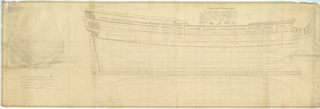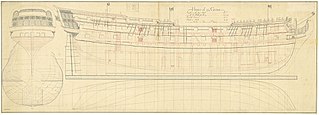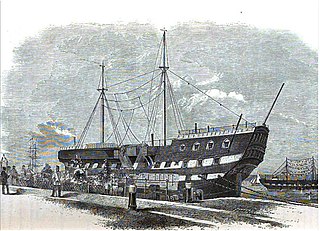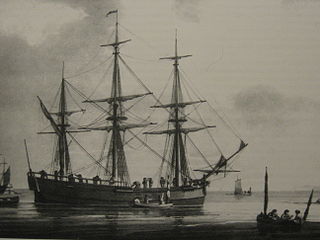
HMS Bellona was a 74-gun Bellona-class third-rate ship of the line of the Royal Navy. Designed by Sir Thomas Slade, she was a prototype for the iconic 74-gun ships of the latter part of the 18th century. "The design of the Bellona class was never repeated precisely, but Slade experimented slightly with the lines, and the Arrogant, Ramillies, Egmont, and Elizabeth classes were almost identical in size, layout, and structure, and had only slight variations in the shape of the underwater hull. The Culloden-class ship of the line was also similar, but slightly larger. Thus over forty ships were near-sisters of the Bellona." Bellona was built at Chatham, starting on 10 May 1758, launched on 19 February 1760, and commissioned three days later. She was the second ship of the Royal Navy to bear the name, and saw service in the Seven Years' War, American Revolutionary War and the Napoleonic Wars.

HMS Vanguard was a 90-gun second-rate ship of the line of the Royal Navy, built at Portsmouth Dockyard and launched in 1678.

HMS Vanguard was a 70-gun third rate ship of the line of the Royal Navy, launched on 16 April 1748. She was built by Philemon Ewer at his East Cowes yard on the Isle of Wight to the draught specified by the 1745 Establishment, at a cost of £8,009. She was the fourth vessel of the Royal Navy to bear the name Vanguard.

HMS Kent was a 74-gun Bellona-class third-rate ship of the line of the Royal Navy, designed by Sir Thomas Slade and built by Adam Hayes at Deptford Dockyard and launched on 23 March 1762.

HMS Hero was a 74-gun third rate ship of the line of the Royal Navy, designed by Sir Thomas Slade built by Thomas Bucknall at Plymouth Dockyard and launched on 28 March 1759. She was the only ship built to her draught.

HMS Ocean was a 90-gun second rate ship of the line of the Royal Navy, launched on 21 April 1761 at Chatham.
HMS Cumberland was a 74-gun third rate ship of the line of the Royal Navy, launched on 29 March 1774 at Deptford Dockyard.

HMS Hector was a 74-gun third rate ship of the line of the Royal Navy, launched on 27 May 1774 at Deptford.

HMS Vengeance was a 74-gun third rate ship of the line of the Royal Navy, launched on 25 June 1774 at Rotherhithe. By 1780, she was at the island of Martinique, and was driven ashore and damaged at Saint Lucia in the Great Hurricane of 1780 but recovered and made her way to Portsmouth to be repaired. Finished in 1803, the ship was put into reserve before becoming a prison ship in the year 1808.

The Alfred-class ships of the line were a class of four 74-gun third rates for the Royal Navy by Sir John Williams. They were an enlarged version of the Royal Oak class.
HMS Eagle was a British 64-gun third-rate ship of the line of the Royal Navy, launched on 2 May 1774 at Rotherhithe.

HMS Royal Sovereign was a 100-gun first rate ship of the line of the Royal Navy, built at Woolwich Dockyard and launched in July 1701. She had been built using some of the salvageable timbers from the previous Royal Sovereign, which had been destroyed by fire in 1697.

HMS Charles was a 96-gun first-rate ship of the line of the Royal Navy, built by Christopher Pett at Deptford Dockyard until his death in March 1668, then completed by Jonas Shish after being launched in the same month. Her name was formally Charles the Second, but she was known simply as Charles, particularly after 1673 when the contemporary Royal Charles was launched.

HMS Falkland was a 50-gun fourth-rate ship of the line of the Royal Navy, built by Holland of New Castle, New Hampshire, and purchased by the navy in 1696.

The Battle of Beaufort, also known as the Battle of Port Royal Island, was fought on February 3, 1779, near Beaufort, South Carolina, during the American Revolutionary War. The battle took place not long after British forces consolidated control around Savannah, Georgia, which they had captured in December 1778.

HMS Lichfield was a 50-gun fourth-rate ship of the line of the Royal Navy, built at Portsmouth Dockyard and launched on 4 February 1695.

HMS Hampton Court was a 70-gun third-rate ship of the line of the Royal Navy, built at Rotherhithe according to the 1706 Establishment and launched on 19 August 1709.
HMS Preston was a 50-gun fourth rate ship of the line of the Royal Navy, built at Deptford Dockyard by Adam Hayes to the draught specified in the 1745 Establishment, and launched on 7 February 1757.
HMS Boyne was a 70-gun third rate ship of the line of the Royal Navy, built at Plymouth Dockyard to the draught specified in the 1745 Establishment as amended in 1754, and launched on 31 May 1766. 1 January, 1775 she's listed under command of Cpt. Brodk Hartwell.

HMS Vigilant was the merchantman Grand Duchess of Russia, converted into a warship during the American Revolution. She served as a transport in North American waters from 1775. The Royal Navy (RN) purchased her in 1777, named her HMS Vigilant, and modified her for shore bombardment duties. She was instrumental in the eventual British success during the siege of Fort Mifflin that same year and supported British operations in Georgia and South Carolina in 1779–80. Her heavy armament proved to be more than Vigilant was designed to handle and she was condemned and burnt in 1780.
















